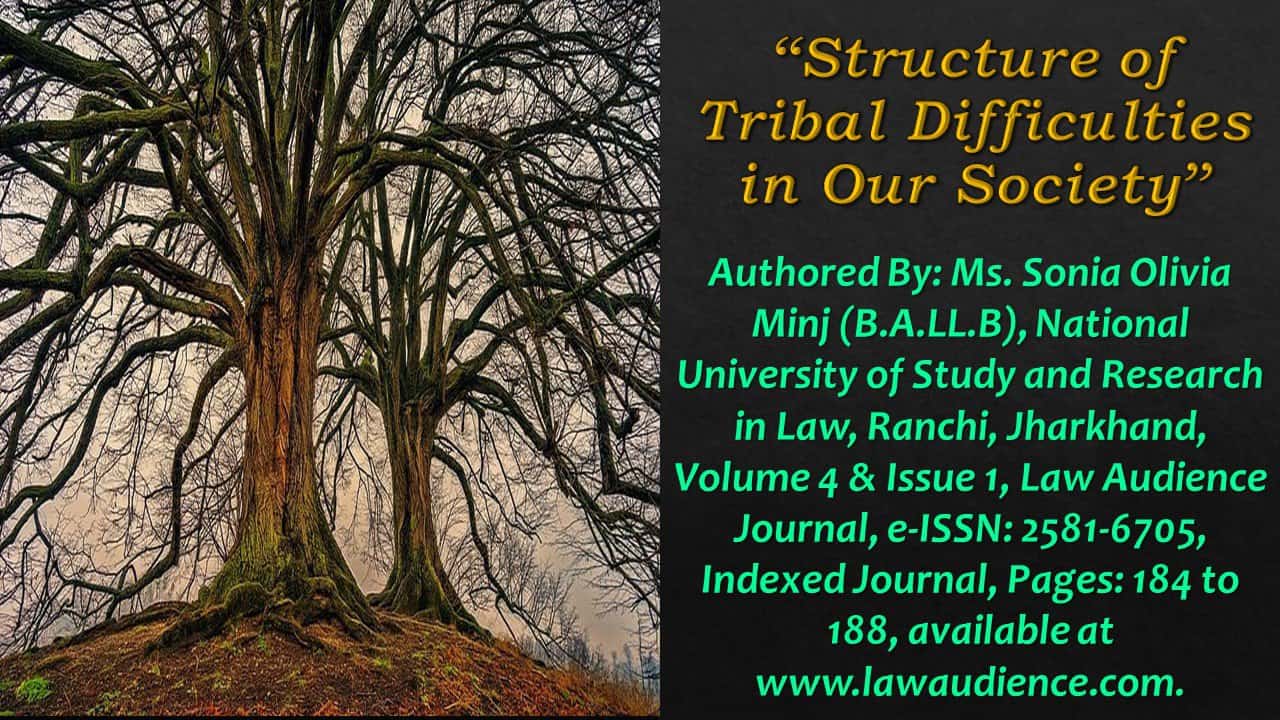Click here to download the full paper (PDF)
Authored By: Ms. Sonia Olivia Minj (B.A.LL.B), National University of Study and Research in Law, Ranchi, Jharkhand,
Click here for Copyright Policy.
I. STRUCTURE OF TRIBAL DIFFICULTIES IN OUR SOCIETY:
Tribal people make up a large portion of India’s population. Different tribal social organisations can be found throughout India. In general, the term “tribe” refers to a basic group of people who live under the leadership of a chief or a headman. A tribe, according to Ralph Paddington, is “a group of people who speak a single dialect, live in a common territory, and have a common culture.”
Verrier Elvin, an anthropologist, was chosen by the Government of India as an advisor to research the tribals of India’s north-eastern region. Jawaharlal Nehru developed the concept of Panchasheel for formulating tribal development policies based on the briefs he provided. According to the POI study, there are 461 tribal groups in the country. There are no similarities across tribes in terms of customs, folkways, eating habits, or ceremonies. Despite their differences, all tribal communities form a society that can be referred to as tribal society. There are several qualities or institutions in this tribal community that are strikingly identical or uniform. There is a legal system for finding a mate, as well as a succession system and a polity. The process of constructing a social organisation eliminates extraneous features in order to highlight abstractions. In India, for example, there are numerous caste and tribal groupings. Each caste has a distinct location and function. Tribes have their own distinct identities. The name and specialties of each tribal group are erased when the social structure is formed. Instead, it is referred to as a ‘caste’ or a ‘tribe.’ These are representations of abstractions.
Tribal societies, which are deemed primitive or barbarous, can be found in tiny numbers in various parts of India, where they face social, cultural, historical, and sociological challenges, as well as substantial prejudice by non-tribals. Humans are biologically identical; they have the same critical organs (heart, lungs, and kidneys) and metabolism. The differences between tribal and non-tribal people are social and cultural, or to put it another way, these differences are created by civilization. As a result, tribal issues are social, cultural, historical, and sociological. The tribal society used to be more or less egalitarian. There has been severe discrimination against tribal people by non-tribal people. The non-tribal has long held the belief that the tribal are a primitive people with limited room for progress. The term ‘minority rights’ encompasses two distinct concepts: first, regular individual rights as they apply to members of racial, class, religious, linguistic, or sexual minorities, and second, collective rights granted to minority organisations. Individual rights of anyone who is not a member of a majority decision may also be referred to as minority rights. Individual rights are frequently denied because of membership in a minority group, according to civil rights groups. Many political bodies recognise minority group rights, which might take the form of affirmative action or guaranteed minority representation in a consociation state.
The Revolutionary Parliament of Hungary declared and established the first minority rights in July 1849. In 1867, Austrian legislation defined minority rights. Minority rights, as they pertain to ethnic, religious, and linguistic minorities, as well as indigenous peoples, are enshrined in international human rights law. Minority rights, like children’s rights, women’s rights, and refugee rights, are a legal framework aimed to ensure that a certain group in society that is vulnerable, disadvantaged, or marginalised achieves equality and is protected from persecution. The United Nations Convention on the Prevention and Punishment of Genocide was the first post-war international pact to safeguard minorities, aiming to protect them from the greatest threat to their survival. The International Covenant on Civil and Political Rights (Article 27), the United Nations Declaration on the Rights of Persons Belonging to National or Ethnic, Religious, or Linguistic Minorities, two Council of Europe treaties (the Framework Convention for the Protection of National Minorities and the European Centre for Regional or Minority Languages), and the Organization for Security and Cooperation in Europe (OSCE) are all later human rights standards that codify minority rights.
II. IMPORTANT TRIBAL ACTIVITIES INCLUDE:
The Scheduled Tribes and Other Traditional Forest Dwellers (Recognition of Forest Rights) Act, 2006, was passed by the Lok Sabha on December 15, 2006, and the Rajya Sabha on December 18, 2006. The President signed it on December 29, 2006, however it was only notified into force on December 31, 2007. (One year later). On January 1, 2008, the Act’s Rules, which cover some of the operating specifics, were notified into force. Protection of Civil Rights Act of 1955; An Act to provide for the enforcement of any disability originating from the [preaching and practise of – “Untouchability”] and for matters associated therewith. SC/ST (Prevention of Atrocities) Act; An Act to prevent the commission of atrocities against members of the Scheduled Castes and Scheduled Tribes, to establish Special Courts for the trial of such offences, to provide relief and rehabilitation to victims of such offences, and for matters connected with or incidental thereto.
The Panchayats (Extension to Scheduled Areas) Act, 1996 (PESA) was enacted by the Indian government to cover the “Scheduled areas” that are not covered by the Indian Constitution’s 73rd amendment or Panchayats Raj Act. It was passed on December 24, 1996, to allow Gram Sabhas to manage their natural resources independently. It is an Act to extend to Scheduled Areas the provisions of Part IX of the Constitution relating to Panchayats.
In most tribal locations, resources are ample, and the community’s economic demands are very minor. The tribal social and economic structure is quite straightforward. They have a long history of self-governance, in which they have managed the community’s day-to-day affairs with much equality and dignity, without the need for outside oversight or involvement. However, in Rajasthan and Gujarat’s western Bhil regions, resources have deteriorated to the point where the population can only survive for a few months each year. The state’s policy on forest, land, water, and excises, which provided a significant portion of tribal people’s livelihood, is one crucial factor that has destabilised the tribal economy in places with abundant resources. The terrible reality is that no matter how successful development programmes are at opening up these places and constructing new infrastructure, the tribal group usually loses out because the benefits of development are often taken advantage of by outsiders. Irrigation dams removed tribals from their fields, wells, and woods, leaving them jobless and forced to seek work elsewhere. Despite the fact that land records still show tribal tenancy, moneylenders are Benami purchasers of their property. In India, economic planning has placed a strong emphasis on meeting the basic needs of the tribal community, assuring their social and economic well-being. Tribal Development Blocks were established in 1956 with this goal in mind, with a focus on individual beneficiary schemes. ‘Food for the year, drinking water during the summer, employment from time to time, fuel, wood for house maintenance, contour bonding for undulated land, and modest irrigation facilities are the basic needs of tribals,’ wrote the Commissioner for Scheduled Areas and Scheduled Tribes in his 1961 report.
The following are the goals of integrated tribal development projects:
1) closing the development gap between tribal areas and other areas,
2) improving tribal communities’ quality of life,
3) integrated development of the TSP area, and
4) planning, implementing, controlling, monitoring, and supervising various schemes for the welfare of tribals in the TSP area.
Despite decades of development efforts, tribals’ major activities are collecting and selling minor forest produce, farming, fishing, hunting, and forest labour. Many people are still unemployed and are looking for work in industrial or other towns. Although there are forests, they are not particularly densely forested. Forests used to play a vital role in tribals’ economic existence, but since the British era, they have been ruthlessly exploited and no longer provide any support to tribal economies. This has unquestionably made these people’s economic situation worse. Droughts have become more common in tribal areas as a result of this. Due to the mountainous topography in many tribal areas, the land is not very fruitful and cannot absorb rainwater.
The poor tribals, with the exception of large farmers, have limited plots of land and do not use fertilizers, improved seeds, or pesticides. As a result, productivity remains normal, and tribals remain poor. Except in a few places, horticulture, income crops, and dairy production are all rare. Tribals are a part of Indian society, yet they are also regarded differently. As a result, any policy aimed at their growth must be participative. Tribes must show off their strengths and take part in development planning. They cannot be developed by outsiders. Their perceived requirements must be converted into successful development programmes, which can only be accomplished through Gram Sabah/Ward Sabah institutions.
The Tribes Advisory Council (TAC) is a body appointed by the state government to monitor and review the working of programmes for the development of Scheduled Areas and advise the Governor on measures to be taken for the welfare and advancement of tribals in the state, according to rules made by the Governor under the provisions of the Fifth Schedule of the Constitution. Members of the Legislative Assembly, the Secretary, and the Commissioner of Tribal Development make up the board, which is chaired by the Minister of Tribal Development. Meetings would be held every three months to ensure effective utilization of authorized funding for tribal welfare and advancement, as they represent tribal population and are intimately familiar with field problems and demands. The goal is to prevent tribals from being exploited and to ensure that special central assistance and tribal sub-plan funds are used properly in the tribal population’s best interests.
Cite this article as:
Ms. Sonia Olivia Minj, “Structure of Tribal Difficulties in Our Society”, Vol.4 & Issue 1, Law Audience Journal (e-ISSN: 2581-6705), Pages 184 to 188 (8th June 2022), available at https://www.lawaudience.com/structure-of-tribal-difficulties-in-our-society/.




